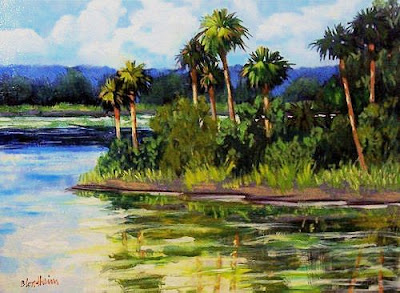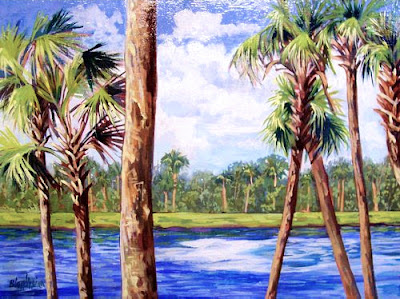
Tall Palms
12x16 inches
oil on panel
gold frame
800.00
Purchase
HEREPainters TipPaper
I found this information about the effects of deterioration of paper. This is for my friends who draw.
Current research suggests that paper will last the longest when kept at a relative humidity of 45%. Ranges of 50-70% are considered acceptable for private homes and studios. Some climates may require a winter humidifier and summer dehumidifier to maintain this standard.
If humidity is too low, it can cause the desiccation and eventual embrittlement of paper. Too much humidity accelerates the growth of mold and the internal decomposition of paper.
Mold is nourished by sizing and paper fibers, and can also feed on the binders used in pastels. The presence of rusty-colored patches indicates that foxing chemical action of mold on the metallic salts in the paper due to prolonged, high humidity is occurring. Exposure to direct sunlight for 1 hour, or enclosure in a closed container with thymol crystals for 2-3 days, will kill mold. Thymol is a fungicide, available at chemical supply houses and some drug stores. Since thymol softens oil paint, it should not be used on oil paintings.
While low temperatures are best suited to the storage of paper products, consistency of temperature is critical. Temperature/humidity fluctuations, called cycling, can often be more detrimental to paper than consistently high temperatures.
Cycling weakens, and eventually breaks down, the fibers of paper by causing expansion and contraction due to water contained within it.
Changes in temperature/relative humidity should be minimal (10' F and 10%), and gradual Some ways to prevent mold and minimize deterioration due to heat and humidity are:
Maintain the lowest, most consistent temperature you possibly can between 60-70' F.
Keep humidity between 45-70%.
Avoid hanging pictures on the outside facing walls, especially if they feel cold or damp.
Avoid framing pictures directly against glass or Plexiglas without a spacer or mat, as this provides an excellent surface for moisture and mold.
Dust framed pictures regularly, as airborne mold spores are contained within dust.
Keep frames away from the wall by inserting small cork squares in the two lower corners of the frame. This creates good circulation and reduces chance of mold growths.
Avoid leaving pictures in a closed room or house for extended periods of time without some form of circulation or dehumidification.
Never hang pictures over a heating register, air duct or fireplace.
Air pollution. Large urban and industrial areas promote a process called sulfation, which occurs when flue gas constituents (water, carbon monoxide, sulfur dioxide, etc.) react to form sulfuric acid. Sulfur dioxide gas is absorbed by paper, where it reacts with moisture to create a destructive sulfuric acid problem within the fibers.
This is called acid hydrolysisCthe reaction of an organic compound with water in the presence of acid. This process breaks down the cellulose, causing discoloration, embrittlement and disintegration of the paper fibers. At normal temperatures, it occurs very slowly, but at elevated temperatures, the process is greatly accelerated.
Sulfuric acid does not evaporate or leave the paper, even after removal from the contaminated area.
Other major pollutants include industrial smoke and particulate matter, photochemical oxidants and haze, motor vehicle emissions, solar radiation, temperature inversions and sodium chloride (prevalent in coastal areas). Solid particles found in polluted air accelerate the deterioration of paper. Dust and grime are abrasive to the surface of paper. In the presence of moisture and in combination with the acid droplets around dirt, they promote a corrosive process which penetrates the fibers as well.
Many compounds are not dangerous themselves, but they promote paper deterioration because they form acids when they mix with atmospheric moisture.
If you live in the urban environment, the only way to combat air contaminants is through an air conditioning and filtration system.
While it is initially an expensive outlay, air conditioning with proper filtration will reduce restoration costs and capital losses of objects, and prove a good investment in time.
Insects.Paper contains ingredients, such as gelatin and glue sizing, wood pulp and flour paste, which are appealing to insects. Cockroaches, silverfish, termites and woodworms are the most common destroyers of paper. Silverfish love dark places and can make nice little homes inside frames as they nibble on sizing and wood pulp. Termites and woodworms like anything made of cellulose, as well as wood, so a rag paper picture in a wood frame is susceptible. Cockroaches can cause damage to paper by eating glue sizing or any painting media containing sugar.
To help prevent infestation of harmful insects:
Clean picture frames regularly.
Never store works of art in dark, damp places such as basements or attics.
Use screens on windows and doors to minimize insects.
Use powdered or aerosol insecticides if signs of insects appear.









































